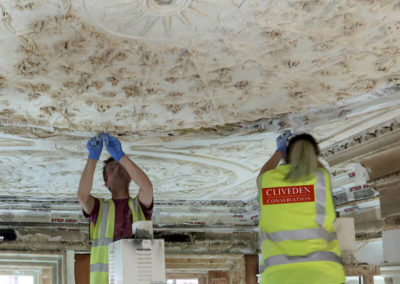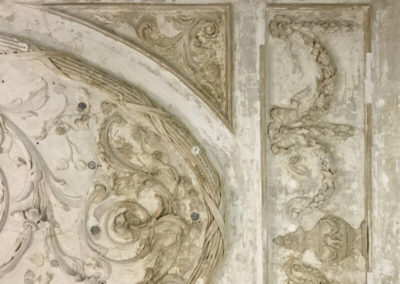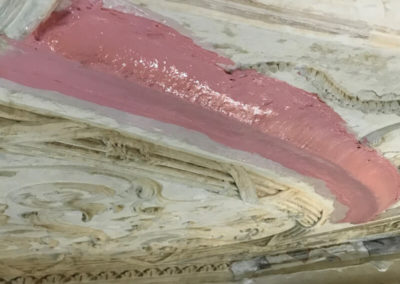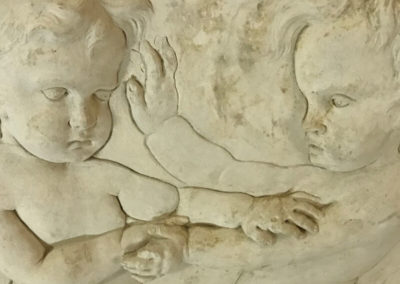Project overview
Project overview
In early 2018 Buxton Building Contractors Ltd were granted the contract for the refurbishment of the Grade 2 listed terraced house at 17 Harley Street, Marylebone, by The Howard de Walden Estate. During the course of their enabling works, a suspended ceiling was removed from the first floor rear room revealing the presence of a hand-modelled stucco ceiling in poor condition. Buxton supported the ceiling on temporary props and commissioned Cliveden Conservation Workshop to survey and write a Condition Report on both ceiling and cornice to include a detailed repair specification. Subsequently Cliveden Conservation was contracted for the repair and redecoration of both ceiling and ornate cornice.
Little is known about the provenance of this ceiling. Research undertaken by Barry Greenstreet of The Howard de Walden Estate has brought to light stylistic similarities to a ceiling by plasterer William Parfitt designed by Sir William Chambers at the now demolished Pembroke House 7, Whitehall Gardens.

‘The ceiling to the main portion of this room is designed on the lines of a spider’s web with an entwining vine, while a large rope of fruit and flowers encircles the ceiling, looping over as a wreath in each corner ‘ From Survey of London Vol 13
Sir William Chambers is also specifically mentioned in the same volume in connection with ceilings in buildings in and around Harley Street. Many of Chambers’ designs have been subsequently demolished and records of his work are scarce so at this point in time further verification is ongoing.
Stylistically it varies from much of the neo-classical work of the time (C.1750) but is in keeping with contemporary methods of construction, in that it is formed of hand-modelled lime stucco on a riven lath and lime base and many of the motifs are recognisably of the period.
Condition as found
The ceiling was found to be in overall reasonable condition apart from the eastern end below the site of a suspected previous water leak which was in a precarious condition and affected both cornice and ceiling, and required propping prior to stabilisation. Multiple cracks and lacunae were visible across the ceiling and there were areas where plaster coats had delaminated and required stabilisation prior to the removal of the props which the Main Contractor has positioned.
The paint surface was in poor condition. This was mostly caused by the poor bonding of later oil bound layers with earlier distemper/limewash layers. Overall the ceiling had fewer coats of paint than would be expected in a ceiling of this age. This was assumed to be the result of the fact that the suspended ceiling had been in place for a considerable number of years.
Conservation work
Primary consideration was given to the stabilising of the ceiling and removal of the props which prevented unrestricted access from below. This took two forms – from below using stainless steel screws and countersunk washers, and from above using stainless mesh trays and wires to strengthen areas of broken or missing laths and give a substrate for replacing plaster where there were voids. This work took place sequentially across the room to enable the removal of props.
Subsequent to the removal of the props a birdcage scaffold was emplaced to enable full access to commence the removal of the paint. Before this was undertaken the desirability had been assessed and samples taken to ensure that in the removal process no historic polychromy would be disturbed. Sampling proved that the ceiling had always been monochrome and because of the poor condition of the remaining paint and overpainting, it was decided to clean back to the original plaster surface.
After conducting trials to ascertain the most effective method, paint removal was undertaken using multiple poultices of Stripaway LV, a non-caustic stripper which was initially mechanically removed prior to a final strip assisted with hand held steamers before final neutralising of the surface with IMS (industrial Methylated Spirit).
This allowed the full non-structural condition of the ceiling to be re-assessed and a final scope of repair works to be drawn up. All cracks were filled and lacunae replaced either in hand-modelled stucco or by taking squeeze moulds of repetitive elements and replacing lost decorative mouldings and other elements.
Decoration
Subsequent to the completion of conservation work, the ceiling was allowed a period of time to fully dry before being redecorated. The ceiling was first mist-coated with Claircolle followed by three coats of soft distemper both supplied by Rose of Jericho.
Project details
Client:
The Howard de Walden Estate
Specialist sub contractor:
Cliveden Conservation (Plaster Section)
Category:







